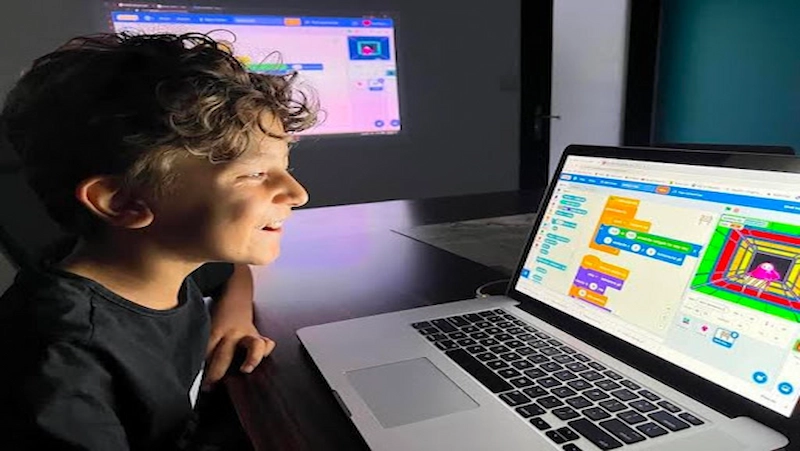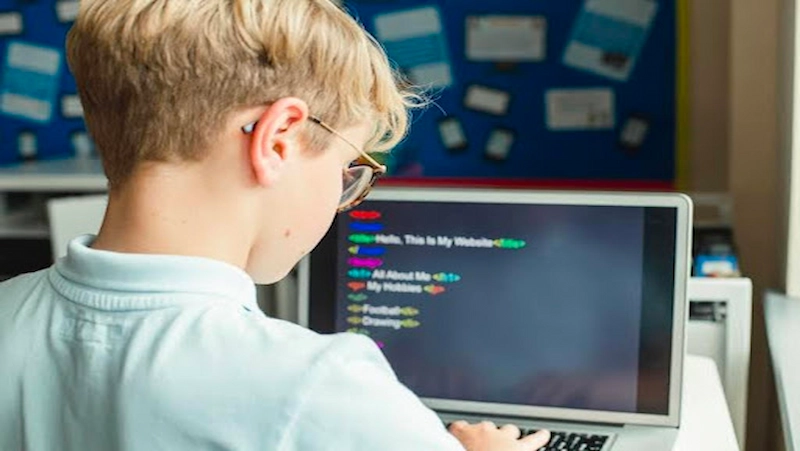In today’s digital age, coding has become an essential skill, and introducing children to coding at an early age can be highly beneficial. With the rapid advancements in technology, coding websites have emerged as a powerful tool for teaching kids the foundations of programming in a fun and interactive way.
By combining education and entertainment, coding websites provide a unique platform for young minds to explore the world of coding and unleash their creativity.
Before diving into the blog, You can check out the video.
Table of contents
Introduction

Coding websites offer a wide range of resources, tutorials, and interactive activities specifically designed for children. These platforms teach coding principles in a visually appealing way that helps students understand difficult subjects.
Code websites turn learning into a thrilling adventure by using vibrant images, interactive games, and detailed instructions, piquing interest and encouraging a love for code.
This adaptability enables kids to study at their own rate, including coding courses into their everyday schedules, and taking into account various learning preferences.
Additionally, coding websites give kids the opportunity to connect with like-minded people from around the world in a welcoming and inclusive community. Children may work together, share ideas, and learn from their peers on these platforms’ many forums, chat rooms, and group projects.
This sense of community encourages teamwork, problem-solving, and communication skills, all of which are important life skills for the future. It also improves their coding skills.
Websites that teach coding also encourage critical thinking skills for kids and problem-solving abilities. As they work their way through coding challenges, children gain the ability to deconstruct complicated issues into more digestible chunks of work.
As they troubleshoot issues and improve their code to get desired results, they hone their logical reasoning, analytical thinking, and tenacity skills. These analytical skills go beyond coding and are useful in many different domains of life.
Choosing the Right Coding Website for Kids

The need of educating students to code has increased in the current digital era. In addition to improving problem-solving abilities, coding fosters creativity and critical thinking. If you’re a parent or teacher, you might be looking for a website that helps kids learn and practice coding on a safe and engaging platform.
With so many possibilities, it’s important to take a few things into account before selecting the most effective coding website for kids. Let’s investigate these elements so that you can make a wise choice.
Age-Related Content:
Coding websites for kids offer a curriculum that is geared toward various age ranges. To make sure the coding lessons, exercises, and games are appropriate for your child’s developmental stage, look for platforms that divide their content into age-appropriate categories.
Children can better understand coding concepts and keep their attention throughout the learning process with the aid of age-appropriate content.
Interactive and Engaging Experience:
Children learn best when they are fully engaged in the process and find it enjoyable. Children can have fun learning to code by using a website that offers engaging coding tasks, games, and riddles.
In order to keep youngsters interested and motivated to continue their coding adventures, look for platforms that employ gamification approaches to teach programming principles in a fun and engaging way.
Free or Affordable Options:
Budget is frequently taken into account while choosing a website for development. Many sites provide free coding lessons or trials, enabling children to learn about coding without being constrained by a limited budget.
To provide your child access to a high-quality coding education without breaking the bank, look for websites that offer free coding resources or reasonably priced subscription options.
Variety of Coding Languages:
There are many different programming languages, however, some are better suited for novice programmers and younger children than others. Popular coding languages like Python, Scratch, and JavaScript are frequently taught in beginner programming courses for kids.
Make sure the coding website you select includes a variety of programming languages so that children can explore various programming concepts and languages as they advance. They can choose a language that best suits their learning preferences and interests thanks to the variety.
User-Friendly Interface:
The coding website’s user interface and navigation should be simple to use and understand, especially for younger users. Children may become less interested in investigating and interacting with the information if the interface is busy or challenging.
Make sure the website you select has an intuitive user experience that enables youngsters to study independently and guides them through coding courses and activities.
Community and Support:
When kids can interact with a helpful community, learning to code is frequently more pleasurable. Search for coding websites featuring forums or communities where children may communicate with other students, post questions, and showcase their own coding creations.
A vibrant community may encourage teamwork, inspire inspiration, and provide direction, increasing the learning process all around.
Track record and reviews:
Before signing up with a coding website, conduct some investigation to determine its reliability and efficacy. Look for endorsements or reviews written by parents, teachers, or other people who have used the site.
Verify whether the website has gotten praise for its course offerings, instructional strategies, and general user experience. A coding website with a proven track record and rave reviews is more likely to give your youngster a worthwhile educational experience.
Getting started with coding websites

Are you interested in introducing your child to the exciting world of coding? Coding for kids has gained immense popularity in recent years, as it equips them with valuable skills for the future.
Learning to code at a young age not only stimulates creativity and problem-solving abilities but also enhances logical thinking and computational skills. With a multitude of coding classes, games, and online resources available, it’s now easier than ever to get your child started on their coding journey.
In this blog post, we’ll guide you through the process of setting up an account and navigating the coding environment on various websites, allowing your child to explore coding in a fun and engaging manner.
What is coding for kids?
Before diving into the setup process, let’s briefly touch upon the concept of coding classes for kids. Writing instructions for computers to carry out certain tasks is known as coding. It’s comparable to teaching computer for kids how to reason and resolve issues.
Kids learn the basics of programming through dynamic, kid-friendly activities when they learn to code. It helps children develop logical thinking skills, the ability to deconstruct complicated issues into simpler ones, and a methodical approach to problem-solving.
Kids who learn to code not only acquire technical skills but also critical cognitive capabilities that are applicable to many aspects of life.
Choosing the right coding platform
There are numerous coding websites and platforms specifically designed for kids. These platforms offer coding classes, games, and resources that cater to different age groups and skill levels. Here are a few popular coding websites to consider:
- CodeChamps by BrightChamps is an extraordinary platform that ignites young minds with the power of coding. It is a creative wonderland where kids dive into the captivating world of programming, learning to unravel complex algorithms and craft their own digital masterpieces. With a holistic curriculum, CodeChamps nurtures the innate problem-solving abilities of children, fostering their creativity and critical thinking. CodeChamps is where dreams come alive, and the future of innovation takes flight.
- A block-based programming language called Scratch was developed by the MIT Media Lab’s Lifelong Kindergarten Group. Kids coding language may drag and drop code blocks to build interactive stories, games, and animations using the visual programming interface that is provided. Scratch offers a thriving online community where kids can share and remix projects and is appropriate for beginners.
- For children of all ages, Code.org provides a variety of coding exercises, tutorials, and courses. It offers classes that make learning to code more interesting by using well-known topics like Minecraft, Star Wars, and Frozen. Code.org is a fantastic resource for both individual learning and classroom settings because it also offers a teacher-led program.
- Tynker is a website that provides youngsters with interactive games and coding lessons. It includes a variety of coding languages, such as Python and block-based programming. Tynker offers detailed instructions, and coding challenges, and even lets youngsters make their own games and apps.
Setting up an account
To get started with coding on these platforms, you might need to set up an account for your child. Here’s a general guide on how to do it:
- Visit the coding website of your choice.
- Look for the “Sign Up” or “Create Account” option. It’s usually located in the top right corner of the website.
- Fill in the required information, such as your child’s name, username, and email address. Some platforms may require parental consent or email verification.
- Create a strong password for the account. It’s important to emphasize the importance of online safety and choosing a secure password.
- Once the account is created, you may have the option to customize your child’s profile, such as adding a profile picture or selecting their interests.
Navigating the coding environment
Your child can start experimenting with the coding environment after the account has been created. Depending on the platform selected, the specific features and design may differ, but the following are some standard components to watch out for:
Home/dashboard:
Your child will land on this page once they log in. According to their ability level, it typically suggests projects, classes, or coding challenges.
Tutorials and courses:
The majority of coding platforms include structured lectures or courses that cover important coding principles. These tools frequently begin with easy exercises and progress to more difficult ones. Encourage your kid to begin with the tutorials at the beginner level and advance at their own rate
Coding editor:
Your child will write and run their code in the coding editor. Depending on the platform, it often consists of a workspace where users can manually input code or drag and drop code blocks. Additionally, the editor might offer sprite libraries, sound effects, and debugging tools.
Community/Project Gallery:
Many coding websites feature a community or project gallery where students may show off their work. This encourages teamwork and serves as motivation for brand-new initiatives. Encourage your youngster to go at other children’s projects and provide encouraging comments.
Help and support:
Coding platforms often provide help and support resources, such as FAQs, forums, or chat support. If your child encounters any difficulties or has questions, they can refer to these resources for assistance.
Tips for teaching coding to kids

Coding has become a crucial skill like Python for kids to learn in the modern digital age. It gives them the ability to reason clearly, work out problems, and unleash their creativity. Early exposure to coding can help kids develop a love of technology and provide them with useful skills for the future.
Creating a positive learning environment and promoting experimentation and creativity are essential for making learning pleasurable and successful. In this article, we’ll look at some insightful suggestions for making teaching coding to children rewarding and interesting.
Start with coding languages that are kid-friendly:
It’s crucial to pick programming languages that are appropriate for kids’ ages and skill levels when teaching them how to code. Popular choices include Python, Blockly, and Scratch.
For instance, Scratch provides a vibrant visual interface that enables kids to create interactive stories, animations, and games. For older children, however, Python is a text-based language that offers greater flexibility and scalability.
You make coding approachable and less frightening by starting with kid-friendly languages.
Use coding games and applications:
Coding doesn’t have to be a boring activity; it can be made into a fun game. Kids may learn programming ideas in a fun and engaging way with the help of a variety of coding games and apps that are made exclusively for them.
Numerous games, challenges, and puzzles are available on websites like Code.org and software programs like Tynker and Kodable that help teach coding concepts while having fun. These games not only keep kids interested, but they also give them a systematic learning route to gradually improve their coding abilities.
Encourage a pleasant Learning Environment:
It is essential to establish a pleasant learning atmosphere for kids to feel inspired and secure while learning to code. Here are some pointers for creating such a climate:
Promote cooperation:
Encourage children to collaborate, exchange ideas, and complete coding tasks as a group. The development of collaboration and problem-solving abilities is aided by this.
Celebrate achievements:
Recognise and applaud each child’s successes, no matter how challenging they may have been. They feel a sense of success as a result, which inspires them to keep learning.
Encourage Creativity and Experimentation:
Coding is a creative process that lets kids express their ideas and imagination; it’s not just about following a set of instructions. Encourage them to think creatively, try out various coding methods, and investigate their own original ideas.
Give them coding assignments that are flexible and allow for creativity and individualization. You may develop your student’s capacity for critical thought and problem-solving by encouraging creativity and experimentation.
Offer Kids Online Coding Lessons and Courses:
As an extracurricular activity, think about signing up children for online coding lessons or courses. These platforms offer a guided learning experience by giving structured curriculum taught by qualified educators.
Kids are guaranteed individualized attention and support through online coding programs, which frequently offer interactive sessions, coding projects, and mentorship. Look for trustworthy websites that specialize in meeting the needs of young learners of coding. Consider exploring a Roblox coding program, which leverages children’s interest in gaming to teach them valuable coding skills in a fun and engaging way.
Conclusion
In today’s technology-driven world, coding has become an essential skill that offers numerous opportunities for growth and success. By introducing coding to kids at an early age, we empower them to become creators rather than just consumers of technology.
The benefits of coding games for kids are vast, ranging from logical thinking and problem-solving skills to creativity and innovation. With a plethora of coding websites designed specifically for free coding for kids, learning to code has never been more accessible and exciting.
Coding websites for kids provide an interactive and engaging platform where young learners can explore the world of programming in a fun and educational way. These websites offer a wide range of coding classes, coding games, and coding courses tailored to suit different age groups and skill levels.
Whether your child is a beginner or already has some coding experience, there are resources available to cater to their individual needs and interests.
The best part is that many coding websites for kids offer free coding resources, ensuring that coding education is accessible to all.
These free coding platforms provide a valuable introduction to coding concepts and allow kids to get a taste of what coding is all about. It’s a fantastic way to ignite their interest and curiosity without any financial barriers.
One such beneficial resource is Google Coding apps for kids, that can prove to be very fruitful for your kids. Children can use coding books as a reference while they begin learning to code and as a terrific way to introduce them to programming ideas. Kids who like to learn independently and at their own pace from the comfort of their homes would greatly benefit from online courses like those provided by BrightChamps.
Frequently Asked Questions
Coding websites for kids are online platforms that offer interactive resources, tutorials, and coding games designed to teach children programming skills. Kids can access coding classes, learn coding languages like Python, and explore computer coding through engaging activities and games.
Coding websites provide a fun and educational environment where kids can learn coding concepts, problem-solving skills, and logical thinking. Through interactive coding games, courses, and activities, these websites make the learning process engaging and accessible to children.
Some popular coding websites for kids include Scratch, Code.org, Tynker, and Khan Academy. These platforms offer a range of coding classes, coding games, and resources tailored specifically for children.
Many coding websites for kids offer free access to their basic coding resources, courses, and games. However, some platforms may have premium features or subscriptions that require payment for full access to their content.
Coding websites for kids are generally designed for children in the age range of 5 to 18. These platforms offer coding lessons and activities tailored to different age groups, allowing kids to start learning at a suitable level for their abilities.
Coding websites for kids provide personalized learning experiences tailored to individual needs and skill levels.
Parents should be mindful of privacy settings and monitor their children’s online activities to ensure a safe coding experience.
Kids can create a wide variety of coding projects, including games, animations, websites, and interactive applications.
Coding websites for kids are suitable for both complete beginners and those with no prior coding knowledge. They offer introductory lessons and step-by-step guidance.
Consistent practice is key, and kids should aim to spend at least a few hours each week on coding websites to see noticeable progress in their skills.


 We are an army of educators and passionate learners from BrightChamps family, committed to providing free learning resources to kids, parents & students.
We are an army of educators and passionate learners from BrightChamps family, committed to providing free learning resources to kids, parents & students.














